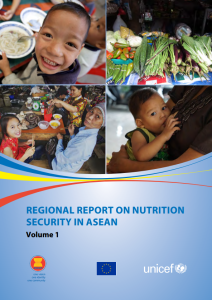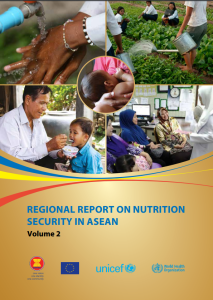Regional Report on Nutrition Security finds children in South East Asia face a ‘double burden’ of obesity and undernutrition
On 28 March 2016, a joint report was launched by UNICEF, the World Health Organization (WHO) and the Association of Southeast Asian Nations (ASEAN) to shed new light on the nutrition situation of children across South East Asia. The report finds that several ASEAN countries are facing simultaneous…
 On 28 March 2016, a joint report was launched by UNICEF, the World Health Organization (WHO) and the Association of Southeast Asian Nations (ASEAN) to shed new light on the nutrition situation of children across South East Asia. The report finds that several ASEAN countries are facing simultaneous crises of over and undernutrition, with some children overweight while their peers suffer from stunting and wasting. This ‘double burden of malnutrition’ is happening in middle income countries such Indonesia, Malaysia, the Philippines and Thailand.
On 28 March 2016, a joint report was launched by UNICEF, the World Health Organization (WHO) and the Association of Southeast Asian Nations (ASEAN) to shed new light on the nutrition situation of children across South East Asia. The report finds that several ASEAN countries are facing simultaneous crises of over and undernutrition, with some children overweight while their peers suffer from stunting and wasting. This ‘double burden of malnutrition’ is happening in middle income countries such Indonesia, Malaysia, the Philippines and Thailand.
“Many countries in South East Asia have seen impressive economic gains in the last decade, lifting millions of children out of poverty,” said Christiane Rudert, Regional Nutrition Adviser for UNICEF East Asia and Pacific.
The causes of overweight and undernutrition are intertwined. A child whose growth was stunted in early childhood is at greater risk of becoming overweight later in life. The risk for being overweight goes up with increased access to junk food and drinks (those with high trans-fat or sugar content and low nutritional value), physical inactivity and sedentary lifestyles. This is an increasing trend in many countries in the region, and contributes significantly to the growing prevalence of chronic diseases like diabetes and heart conditions.
 Regional Report on Nutrition Security in ASEAN: Volume 1 Download PDF (English) (2.39 MB)
Regional Report on Nutrition Security in ASEAN: Volume 1 Download PDF (English) (2.39 MB)
Regional Report on Nutrition SEcurity in ASEAN: Volume 2 Download PDF (English) (3.58 MB)
Learn more at UNICEF EAPRO